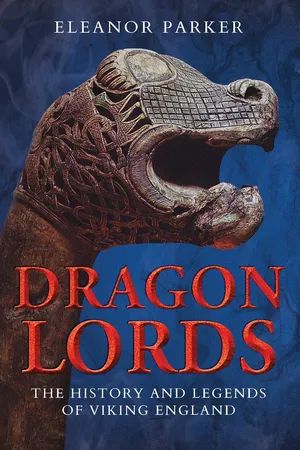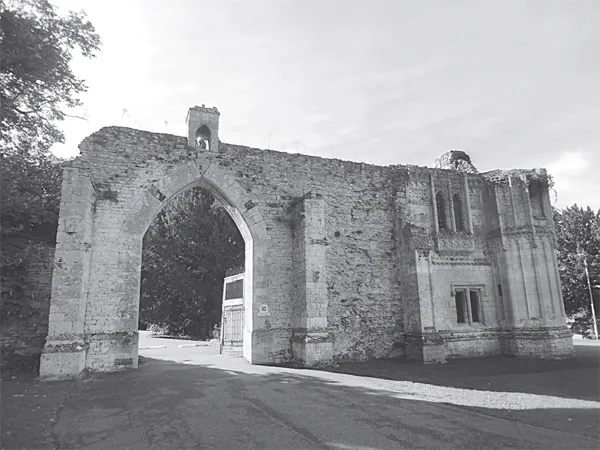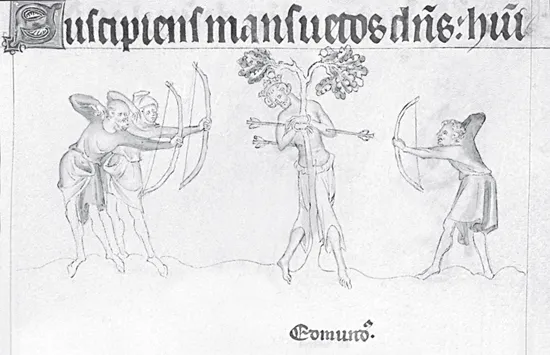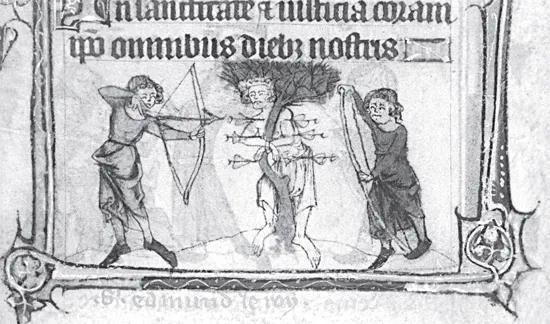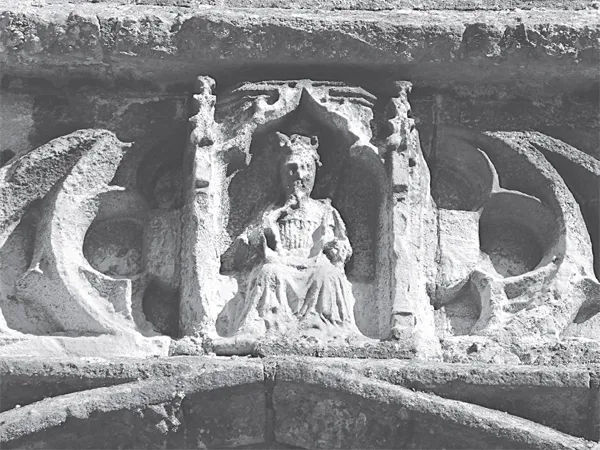![]()
CHAPTER 1
‘From the north comes all that is evil’: Vikings, kings and saints, c.985–1100
The last decades of the tenth century saw an intensification of Viking activity in England, after a period of relative calm. From the 980s onwards England was again being raided by a number of Scandinavian armies at once, working separately or together, in search of plunder and, eventually, of conquest. The poem which has most often been used to exemplify literary representations of the Vikings in this tense period is The Battle of Maldon, which memorialises a battle fought between an English army and a force of Vikings on the coast of Essex in 991.1 Although the English were defeated, the poem casts their loss in a heroic light: the conflict is framed as a national struggle against an army of Vikings, who are described as wælwulfas (96), ‘slaughter-wolves’ and hæðene scealcas (181), ‘heathen warriors’.2 They are a nameless, faceless band: the poem provides us with a great deal of information about the names, families and homes of many of the English warriors, from the high-ranking leaders of the army to the most humble foot-soldier, but not a single member of the Viking force is given a name. Since the leaders of the Viking army may well have included some prominent men, among them Svein Forkbeard, king of Denmark, this seems like deliberate and wilful ignorance – a poetic choice, a conscious decision to deny the Danes any kind of differentiating or individualising details.3
In this poem the leader of the English army, Byrhtnoth, famously returns a fiercely defiant answer to the Viking messenger who comes to demand money in exchange for peace: he offers the Danes spears instead of tribute, a rhetorical flourish we will encounter again. As he stands on the Essex shore, he calls the Vikings brimmen (49), ‘seamen’, creatures of the waters, and talks about defending eþel þysne (52), ‘this homeland’, linking the land on which the Vikings are encroaching to the very name of the English king – this eþel, his wordplay implies, cannot be anything other than Æthelred’s land. The picture is of a strong, united England standing behind Byrhtnoth, ready to repel the raiders who have come from the sea. His rhetoric is powerful, but even within the poem it proves to be futile: despite his threats, it is Byrhtnoth himself who falls in battle, the consequence of having allowed the Vikings too far onto the land. In later medieval narratives of this period, the poem’s play on Æthelred’s name was to be overtaken by another and less flattering pun: the king has gone down in history as the ‘unready’, since in Old English Æthelræd means ‘noble counsel’, and unræd is the opposite, ‘bad counsel, lack of wisdom’. Modern historians have increasingly been kinder in their assessment of Æthelred’s reign than their medieval counterparts,4 but it is true that Æthelred and his counsellors were unwise or unlucky in most of their attempts to mount an effective response to the Viking threat. In the aftermath of the battle at Maldon, they decided to pay tribute to the Danes in the hope of encouraging them to stay away – the very policy scorned by Byrhtnoth in the poem. Nonetheless, attacks continued on and off for the next two decades.
5. A modern statue of Byrhtnoth, killed fighting against the Vikings in 991, at Maldon in Essex
The entries in the Anglo-Saxon Chronicle for these years record a catalogue of destruction, listing towns and manors throughout the country which were plundered and burned by the Danes.5 But not all the devastation of these years was caused by the Vikings. In 1002, Æthelred gave an order that ‘all the Danes who were among the English people’ should be killed, apparently because he was afraid they were plotting against his life.6 The order was to be carried out on St Brice’s Day, 13 November, and we know from a contemporary source what happened in one southern town: in Oxford, a group of Danes were pursued by the townspeople and took refuge in St Frideswide’s church, on the site of what is now Christ Church Cathedral. Their pursuers set fire to the church, and it was consumed by the flames. As we will see, later medieval narratives of the period give prominence to St Brice’s Day as a crucial moment in Æthelred’s downfall and the rallying of the Danes.
6. The gatehouse of Ramsey Abbey, all that remains of the medieval abbey where the first works on St Edmund were written in the tenth century
In these years the history of earlier Viking invasions was now a matter of pressing relevance, and a growing interest in this history can be traced in various sources from the end of the tenth century. This was a period of flourishing in the cult of St Edmund of East Anglia, the most famous victim of the ninth-century Danish conquest, and in the closing decades of the tenth century the earliest important works on St Edmund were produced. In 985–7, while staying at Ramsey Abbey, the monk and scholar Abbo of Fleury wrote a Passio Sancti Eadmundi, providing the first authoritative account of Edmund’s death at the hands of the Danes.7 Within a decade or so Abbo’s text was translated into English by the prolific homilist Ælfric, who explains the chain of transmission on which his account draws:
Sum swyðe gelæred munuc com suþan ofer sæ fram sancte Benedictes stowe on Æþelredes cynincges dæge to Dunstane ærce-bisceope, þrim gearum ær he forðferde, and se munuc hatte Abbo. Þa wurdon hi æt spræce oþþæt Dunstan rehte be sancte Eadmunde, swa swa Eadmundes swurd-bora hit rehte Æþelstane cynincge þa þa Dunstan iung man wæs, and se swurd-bora wæs forealdod man. Þa gesette se munuc ealle þa gereccednysse on anre bec, and eft ða þa seo boc com to us binnan feawum gearum þa awende we hit on englisc, swa swa hit her-æfter stent.8
(In the days of King Æthelred, a very learned monk came from the south across the sea from St Benedict’s monastery [Fleury], to Archbishop Dunstan, three years before he died; and the monk was called Abbo. They talked together until Dunstan told the story of St Edmund, just as Edmund’s sword-bearer told it to King Æthelstan in the days when Dunstan was a young man and the sword-bearer was a very old man. Then the monk set down all the story in a book, and afterwards when the book came to us a few years later we turned it into English, as follows hereafter.)
This is a summary of Abbo’s own preface, in which he describes Dunstan telling the story of Edmund’s death in his presence, with tears flowing from his eyes, recounting what had been told to him by Edmund’s aged sword-bearer. Abbo’s Passio, which is dedicated to Dunstan, does not explain what prompted the archbishop to recall this story, and only says that he decided to write it down to prevent Dunstan’s memories from being forgotten. The association with Dunstan, the dynamic and influential Archbishop of Canterbury, and with Æthelstan, one of the most glorious of Anglo-Saxon kings, gives Abbo’s narrative an authenticating pedigree. If it is accurate, it also provides a striking example of how information might be transmitted in oral tradition across the course of more than a century,9 and seems to reveal a surge of interest in Edmund’s story at two key moments in the years between his death in 869 and the time of writing, 985–7: first at Æthelstan’s court in the 930s, where Dunstan supposedly heard the story from Edmund’s sword-bearer, and again, half a century later, in the reign of Æthelred. Both were moments when the history of Viking invasion in England may have seemed of particular contemporary relevance: Æthelstan was celebrated for his victories over the Vikings, especially the battle of Brunanburh,10 while in the 980s Dunstan had good reason to be interested in the resumption of Viking attacks. Dunstan died in 988, and it was soon being said that he had prophesied the return of the Vikings: the belief that he had prophetic foreknowledge of the Danes’ return is first mentioned in a series of lections for St Dunstan’s feast composed by Adelard of Ghent between 1006 and 1012.11 Abbo’s reference to Dunstan recalling his memory of St Edmund’s story suggests that Dunstan may indeed have taken an interest in this question towards the end of his life.
7a. St Edmund’s death depicted in a fourteenth-century Psalter (British Library, Royal MS. 2 B VII, f. 277)
The view of the Danes in Abbo’s Passio Sancti Eadmundi presents what was to become a very familiar picture – to some degree, it is the canonical interpretation, to which many of the later narratives we will look at are responding. Abbo tells how the saintly King Edmund, virtuous, generous and just, attracts the hatred of the devil, who sends agents to destroy him. These are the Danes Ivar and Ubbe, later identified in English and Scandinavian tradition as the sons of Ragnar Lothbrok. Abbo attributes the evil inclinations of these villains to their northern origins:
[…] conatus est in exterminium adducere totius fines Britanniæ. Nec mirum, cum venerint indurati frigore suæ malitiæ ab illo terræ vertice, quo sedem suam posuit […] [C]onstat, juxta prophetæ vaticinium, quod ab aquilone venit omne malum, sicut plus æquo didicere perperam passi adversos jactus cadentis tesseræ, qui aquilonalium gentium experti sunt sævitiam.
([they attempted] to reduce to destruction the whole confines of Britain. And no wonder! seeing that they came hardened with the stiff frost of their own wickedness from that roof of the world where [Satan] had fixed his abode […] [I]t is proverbial, according to the prediction of the prophet, that from the north comes all that is evil, as those have had too good cause to know, who through the spite of fortune and the fall of the die have experienced the barbarity of the races of the north.)12
The peoples of the north are pagans, pirates, even cannibals, Abbo explains, and nothing but evil can be expected from them; they are the instrument of God’s punishment against the wicked, and a tool of the devil. He has biblical authority for this, alluding to the words of the prophet Jeremiah: ‘from the north shall an evil break forth upon all the inhabitants of the land’, a passage often linked by early medieval writers to the Vikings.13
Abbo goes on to tell how Ivar and Ubbe descend on the English coast with fire and destruction, and their terrible crimes – pillage, rape, the murder of children – are committed ‘from sheer love of cruelty’.14 When the Danes reach East Anglia, Ivar demands that Edmund pay him tribute and become his under-king, but Edmund scornfully refuses. He is seized by the Danes and brutally murdered, shot through with arrows and finally beheaded. The Danes hide his head in a wood – an act Abbo ascribes to their pagan hatred for Christian burial – but it is carefully guarded by a wolf until it is found by Edmund’s followers and rejoined to his body. These elements of the story – Edmund’s body covered with arrows, the severed head miraculously calling out to its rescuers, the protective wolf – became hugely popular aspects of the saint’s iconography, widely depicted and repeated for many centuries to come.15
7b. St Edmund’s death, from a fourteenth-century Book of Hours (British Library, Yates Thompson MS. 13, f. 192)
7c. A fifteenth-century carving of Edmund, above the door of St Edmund’s Church, Kessingland, Suffolk
7d. St Edmund’s death, from a window in St Mary’s Church, Bury St Edmunds
7e. A statue of St Edmund by Elisabeth Frink, near the site of the abbey of Bury St Edmunds
Abbo’s text was an influential one, establishing the key features of the cult of a martyr who was to become one of the most celebrated English saints, as well as a prevalent interpretation of the actions and motivations of the Vikings. It casts the Danes as enemies of Christianity and as instruments of the devil, framing Viking attacks on England as a moral conflict between good and evil. The response to such a threat can never be political accommodation, or an acknowledgement that the Danes might have played any role in East Anglian history other than that of foreign enemy; they are fundamentally inimical to English Christian society, and so the resumption of Viking raids is to be interpreted, from the perspective of the late tenth century, as a continuation of this evil – rather than, for instance, an attempt to reconquer territory once under Danish rule.16 In his English version of Abbo’s Passio, Ælfric makes the relevance of this saint’s death to his own time explicit, switching into the present tense when describing how ‘þa deniscan leode ferdon mid scip-here hergiende and sleande wide geond land swa swa heora gewuna is’ (‘the Danish people came with a ship-army, raiding and slaying throughout the country, as is their wont’).17 Ælfric’s grim aside underlines a strong perception of continuity between the ninth-century Danish invasion and his own time, more than a century after Edmund’s death: this is the Danes’ usual custom, their unpleasant but apparently innate habit. Ælfric does not repeat Abbo’s comments on the iniquity of everything that comes from the north – this bitter remark serves as sufficient explanation for the Danes’ behaviour.
Even in this tense period, however, the history of the Danes in England was also recognised to be a complex subject, which over the years had involved settlement and integration as well as violence. Fifteen years or so after Abbo produced his Passio Sancti Eadmundi while staying at ...
